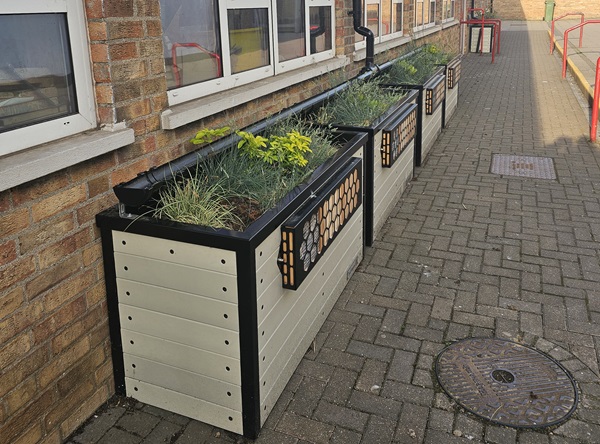Wold Construction specifies six BioScapes SuDS & BNG planters to address severe flooding issues at Hornsea School and Language College
Wold Construction specifies six BioScapes SuDS & BNG planters to address severe flooding issues at Hornsea School and Language College
Background: Managing flood risk and educational engagement
Hornsea School and Language College, located in a flood-prone area at the foot of a hill, faced recurrent challenges with surface water run-off during heavy rains. Severe flooding in 2006 underscored the need for an effective solution to protect the school’s infrastructure, ensure the safety of its students and staff and prevent disruption to education.
Despite the availability of government funding for Sustainable Drainage Systems (SuDS), many schools hesitated due to concerns over potential ground-work disruptions. Hornsea School required a flood management solution that was both effective and minimally invasive.
Additionally, the school saw an opportunity to link environmental infrastructure to its educational goals, particularly in fostering awareness among students about sustainable practices and climate resilience.
While the benefits of SuDS for flood management were clear, integrating these systems in a way that resonated with both staff and students required thoughtful planning and design.
Solution: BioScapes® SuDS Units – A local, innovative and educational choice
Hornsea School partnered with Wold Construction and East Riding Council to install six BioScapes SuDS units. These units were selected for their surface-mounted, retro-fit design, which eliminated the need for intrusive groundwork, ensuring a swift and disruption-free installation.
Key features of the BioScapes SuDS system include:
- High Attenuation Capacity: With a capacity of 350 litres per unit and an outflow rate of 0.05 litres per second, the system can delay flood peaks by 11 minutes during a 1-in-10-year storm event, significantly reducing flood risk.
- Educational Integration: The system’s visible, above-ground design allows students to directly observe how it works, linking classroom learning to real-world applications.
- Biodiversity Benefits: The SuDS planters support local biodiversity, with plants thriving in the units since their installation in October 2024.
Results: Measurable environmental and educational impact
Since installation, the BioScapes SuDS units have proven their effectiveness in managing flood risks, with no significant disruptions to school activities during severe weather events. The modular “drip system” ensures water flows slowly and steadily through the units, reducing the volume and speed of run-off.
The benefits extend beyond flood prevention with students and staff embracing the project, as the school’s Site and Safety Manager, Dave Jordan, explains:
“We are thrilled with the units. They are robustly built but are nicely styled to complement the look of the school. Their effectiveness has been thoroughly tested to the extent that I am really keen to apply for additional units.The delivery and installation process was a breeze and the plants have taken really well but what’s really encouraging is the positive feedback from the rest of the staff and pupils, they really seem to get the concept and the need. I’ve had A-level students expressing how helpful and interesting it’s been to see SuDS units in person – having learned about them in their courses.I’m actively working with East Yorkshire Council to secure funding to install more units next year.”
Conclusion: A blueprint for sustainable schools
Hornsea School and Language College’s adoption of BioScapes SuDS units demonstrates how innovative, minimally invasive infrastructure can simultaneously address environmental challenges and enhance educational outcomes. By leveraging local expertise through Wold Construction and BioScapes, embracing cutting-edge solutions, the school has set a standard for sustainable practices in education.
This case study underscores the value of integrating functional infrastructure with learning opportunities, showcasing how schools can play a pivotal role in fostering environmental awareness while safeguarding their communities against climate-related risks.


